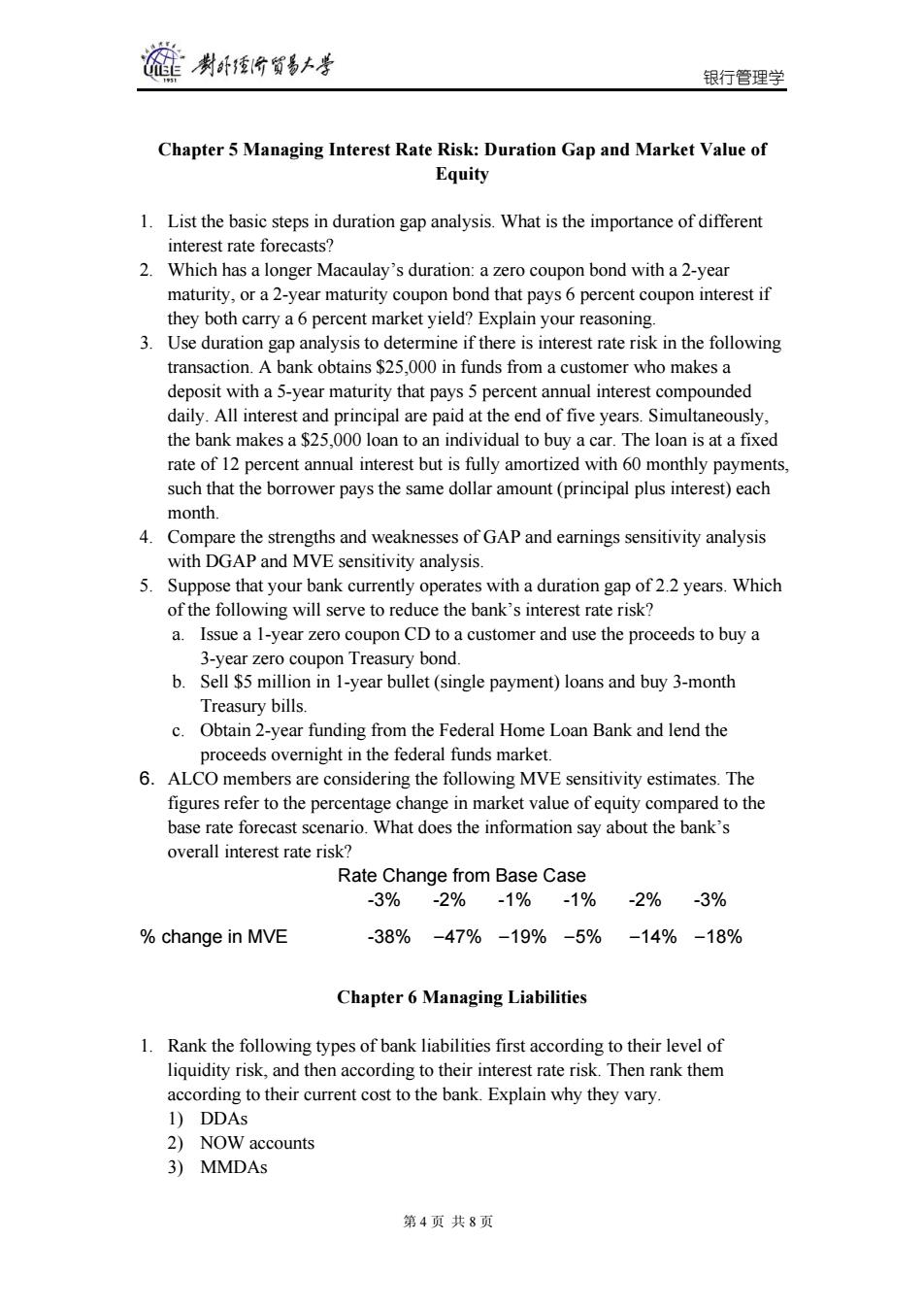正在加载图片...

溢 制卧爱分贸多本芳 银行管理学 Chapter 5 Managing Interest Rate Risk:Duration Gap and Market Value of Equity 1.List the basic steps in duration gap analysis.What is the importance of different interest rate forecasts? 2.Which has a longer Macaulay's duration:a zero coupon bond with a 2-year maturity,or a 2-year maturity coupon bond that pays 6 percent coupon interest if they both carry a 6 percent market yield?Explain your reasoning. 3.Use duration gap analysis to determine if there is interest rate risk in the following transaction.A bank obtains $25,000 in funds from a customer who makes a deposit with a 5-year maturity that pays 5 percent annual interest compounded daily.All interest and principal are paid at the end of five years.Simultaneously, the bank makes a $25,000 loan to an individual to buy a car.The loan is at a fixed rate of 12 percent annual interest but is fully amortized with 60 monthly payments, such that the borrower pays the same dollar amount(principal plus interest)each month. 4.Compare the strengths and weaknesses of GAP and earnings sensitivity analysis with DGAP and MVE sensitivity analysis. 5.Suppose that your bank currently operates with a duration gap of 2.2 years.Which of the following will serve to reduce the bank's interest rate risk? a.Issue a 1-year zero coupon CD to a customer and use the proceeds to buy a 3-year zero coupon Treasury bond. b.Sell $5 million in 1-year bullet(single payment)loans and buy 3-month Treasury bills. c.Obtain 2-year funding from the Federal Home Loan Bank and lend the proceeds overnight in the federal funds market. 6.ALCO members are considering the following MVE sensitivity estimates.The figures refer to the percentage change in market value of equity compared to the base rate forecast scenario.What does the information say about the bank's overall interest rate risk? Rate Change from Base Case 3%-2%-1% -1% -2% -3% change in MVE -38%-47%-19%-5% -14%-18% Chapter 6 Managing Liabilities 1.Rank the following types of bank liabilities first according to their level of liquidity risk,and then according to their interest rate risk.Then rank them according to their current cost to the bank.Explain why they vary. 1)DDAs 2)NOW accounts 3)MMDAs 第4页共8页银行管理学 第 4 页 共 8 页 Chapter 5 Managing Interest Rate Risk: Duration Gap and Market Value of Equity 1. List the basic steps in duration gap analysis. What is the importance of different interest rate forecasts? 2. Which has a longer Macaulay’s duration: a zero coupon bond with a 2-year maturity, or a 2-year maturity coupon bond that pays 6 percent coupon interest if they both carry a 6 percent market yield? Explain your reasoning. 3. Use duration gap analysis to determine if there is interest rate risk in the following transaction. A bank obtains $25,000 in funds from a customer who makes a deposit with a 5-year maturity that pays 5 percent annual interest compounded daily. All interest and principal are paid at the end of five years. Simultaneously, the bank makes a $25,000 loan to an individual to buy a car. The loan is at a fixed rate of 12 percent annual interest but is fully amortized with 60 monthly payments, such that the borrower pays the same dollar amount (principal plus interest) each month. 4. Compare the strengths and weaknesses of GAP and earnings sensitivity analysis with DGAP and MVE sensitivity analysis. 5. Suppose that your bank currently operates with a duration gap of 2.2 years. Which of the following will serve to reduce the bank’s interest rate risk? a. Issue a 1-year zero coupon CD to a customer and use the proceeds to buy a 3-year zero coupon Treasury bond. b. Sell $5 million in 1-year bullet (single payment) loans and buy 3-month Treasury bills. c. Obtain 2-year funding from the Federal Home Loan Bank and lend the proceeds overnight in the federal funds market. 6. ALCO members are considering the following MVE sensitivity estimates. The figures refer to the percentage change in market value of equity compared to the base rate forecast scenario. What does the information say about the bank’s overall interest rate risk? Rate Change from Base Case -3% -2% -1% -1% -2% -3% % change in MVE -38% -47% -19% -5% -14% -18% Chapter 6 Managing Liabilities 1. Rank the following types of bank liabilities first according to their level of liquidity risk, and then according to their interest rate risk. Then rank them according to their current cost to the bank. Explain why they vary. 1) DDAs 2) NOW accounts 3) MMDAs